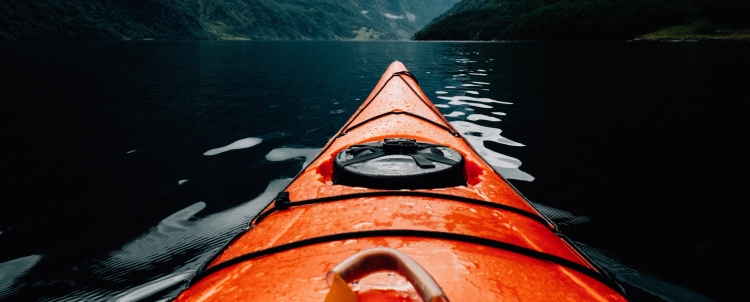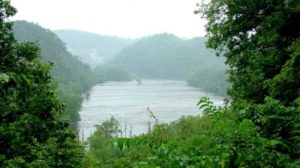
The headwaters of the Hiwassee River emerge off the northern slopes of Rocky Mountain in Georgia’s Appalachian region. These waters crash and cascade into one another and build momentum as they travel northward across ancient altars of rock. The currents trickle through smoky Blue Ridge forests as they twist and turn on a long journey to the steady shallow pool of Lake Chatuge. From this reservoir, the Hiwassee travels far across western North Carolina, gaining momentum. Moving westward, Lake Hiwassee and Lake Apalachia both pool and channel the river into southeastern Tennessee as the run drains across the mountains to the Great Tennessee River Valley.
On the Tennessee side of the mountains, roughly thirty miles from the border of North Carolina, the family and I have decided to take an adventure on the Hiwassee. The river flows gently. Five miles downstream, my family wagon awaits us at the Reliance Boat Ramp in Polk County, Tennessee. Our kayaks sit on the faded asphalt near the Powerhouse Recreation Area. I’m eyeing the boat ramp and the wide river we’re about to give a ride. Trickling along, the Hiwassee’s song calls to us. I’m a bit nervous, as this is our first real spin on a river. We recently inherited these kayaks from Katie’s dad. The family and I have taken a few practice runs around Knoxville, but today’s journey will put our amateur skills to the test.
Let’s get these kayaks on the current. We couldn’t have asked for a more perfect day. In our last days of summer, autumn hints of her arrival. The sun still burns hot, but the air is rather cool in the forest shade. Further, the air feels dry. Though some summer humidity is still present, our days are breaking. Seems the local forest can tell the difference as well. Most leaves are still a deep, harmonious green, but some outliers here and there have started to rust and abscise in a soft breeze – they feather and dance on their way to the forest floor to rest, rot, and decay. Yet green, the color of life, is all around. A healthy display of oak trees shade the pine boughs. The knotty shadows reach across walnut’s pinnate leaves swaying above hickory trees, and a slight breeze fans the sweet, woodsy scent through the air. Fun to stand in the green glow of summer knowing the fiery splendor of autumn is just weeks away.
Our kayaks are packed with water, food, towels, and clothes in waterproof bags. We all wear navy-blue life vests. Katie has finished tying off her gear and looks up from her kayak.
“Who you going to float with today, Bubba?” She stands and approaches our boy, smiling.
Eli turns toward her, drops the stick he was poking into the ground, and, in a soft but excited voice, says,
“I think Daddy.”
“Well heck yeah, Dudester!” I exclaim. Eli catches my eye and his bashful smile suggests he’s happy I want him with me.
“Are we ready to drop in?” I smile at the family.
Katie locks up her car and looks at our kayaks. “I think so. Time to float.”
I smile and pick up one of our vessels. “Let’s go.”
With our kayaks on the boat ramp, Katie lets me hop in and settle Eli in front of me. She then gives us a push into the water. Shortly after, she wiggles herself free of the boat ramp and begins paddling over to us.
“Okay, Buster Bean, I need you to know what to do if we happen to fall out.”
“Oh, okay, but why though, Dad?” Eli inquires with a nervous curiosity.
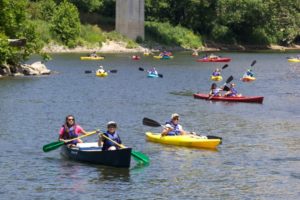
“Well, buddy,” I answer, “it’s just good to have a game plan. I think this will be smooth sailing. There are kids all over the place. We’ve done a lot of reading and this is supposed to be a beginners stretch of the river. But, just know, no matter who you are riding with, if the kayak flips over, stay calm. Your life vest will keep you above water, plus you are a good swimmer. Your mom and I will make you our very first priority and get you to safety.”
Everything I said is true. Families of all ages are in kayaks, rafts, canoes, even tubes in the river. Still, I feel some nerves, myself, being out here. The Hiwassee, though, is beautiful. I feel hugged between lush ridge lines. An array of puffed, downy clouds whisp across a royal blue sky. The air is warm and cool at the same time, touching a faint autumn crispness. A perfect breeze dances across our skin and rattles leaves along the surrounding forest.
The Hiwassee sings away as rippling lapis water moves over angular rock, rounded cobble, coarse sand, and fine silt. I’m simply enchanted by the mountain scene from the view of the river.
This living world is fragile, yet spectacular. The wild, wherever and however experienced, is a marvel. The mountains are a place where the cosmos lives and breathes – where atoms and molecules evolve complex systems of rock, water, climate, and life. All the natural world moves in a rhythm – a rhythm of dazzling variety. In the river valley, in this calm moment on the water, as the Hiwassee glides and shines in the last days of the summer sun, an absolute wonder of rock, soil, water, and life are on full display. The natural world is brilliantly complex, comprising billions of individual organisms, across millions of different plant species, wildlife, fungi, and even simpler forms across the three great domains of life. Our species is at home on this unique rock, our Earth. We benefit from the energy of our sun and the Earth’s very minerals, on which we stand. An ease comes over me as I subtly paddle. This ongoing pandemic is surely evidence that life, all life – our human lives included – is interconnected. Our species is part of this grand mechanism, yet this magnificent biodiversity is in decline. The natural world is failing. We walk the halls of time during an ongoing mass extinction.
The first small rapids of the river approach. The shallow, blue water rushes forward and turns white as it collides against stone.
“Hey buddy, remember what I told you, okay?” I paddle and drag the oar to balance our kayak as we head toward the rapids.
Eli remains silent but nods his head in agreement. Along the banks, my eye catches the Ocoee Leatherflower, which is losing a pink bloom as September ages.
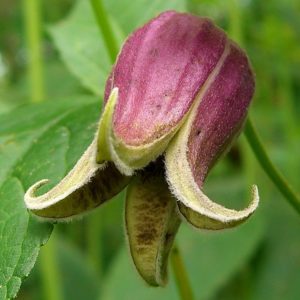
Still, the flower moves in rhythm with Ruth’s Golden Aster, a federally endangered species that only grows among the river rocks of the Ocoee and our Hiwassee rivers. We float past these plants as our boat gains speed. The waters splash and dance all around and our soft giggles quickly turn to fits of howling laughter.
“That was fun!” We holler in unison and all those special flowers roll by until they are behind us. Their precise habitat makes them particularly vulnerable, especially since we’re losing our wild spaces.
The loss of wild spaces happens slowly. An acre here, a hectare of deforestation there, is hardly noticeable day by day. As decades roll on, however, the loss of wilderness is vivid.
The boy and I have a good chatter going as we see a second round of rapids on the river. This time, though, a small cascade is followed by a roughly two-foot plunge. We get excited for the rapid, but Katie topples into the water ahead of us. My heart sinks a bit as I yell for Eli to brace himself for the run. As the boy and I cross the rapids to the plunge, the velocity of the water turns our kayak sideways. In an instant, we flip over and splash into the water.
The river is cool but very pleasant. The roar of the rapids is loud but not loud enough to drown out Eli’s cries. I grab him immediately and pull him close. Being wrapped in my arms calms him down.
I was chuckling softly to myself, signaling to the boy that we are alright, no one is hurt, and the water feels good.
“I got you buddy, I got you. Everything is okay.” I reach out and grab the kayak with a free hand and loop the oar through a side strap.
Katie has mounted her kayak again and comes paddling over to us.
“Well, that was a splash! Come on over, Eli!” she beckons.
“Okay.” Eli stretches his hands to his mother. As she picks him up, he half laughs and half cries about our flip.
“I know that was scary baby boy, but your dad and I got you.” Katie consoles our child with a soft voice. “We won’t let you get away from us.” Eli nods.
I turn my attention back to myself as the water gurgles all around me. I can touch parts of the river bottom; other spaces are too deep. As such, I cannot find a footing to hoist myself back on to the kayak. When I try to pull myself back up, the blue vessel just flips back over on me. I look around and simply laugh at myself. The water feels wonderful, so I decide to coast a little bit and just enjoy the Hiwassee washing over me. No need for the dramatics. In time the current slows, I find my footing, and hoist myself back into the kayak. As we coast the river, I admire an exposed outcrop of blue-black slate, a metamorphic rock interstratified with lenticular layers of dove-colored limestone. These rocks offer a glimpse back in time – hundreds of millions of years ago, in fact – and they tell the tale of this mountainous region’s formation.
As the Proterozoic turned to the Paleozoic Era, a chain of volcanic islands collided with the ancestral North American plate. This collision caused huge sheets of rock to be thrust on top of one another. They moved westward along faults in the rock layers. As continental plates tectonically moved across the mantle, a second collision would bring the ancestral African plate – called Gondwanaland – into the North American plate, thus closing the once mighty Iapetus Sea. This collision would cause the Appalachian Mountains to fully rise from the Earth as plate tectonics built the supercontinent known as Pangea. Rocks buckled into folds and slid over one another. Heat and pressure would transform some sedimentary rocks into metamorphic rocks. This metamorphic process turned the shales in this area to the slate I admire today. These bands of blue-gray slate and dove-colored limestone along the gorge were once simply layers of sediment that deformed some 460 to 240 million years ago during the Appalachian orogeny.
This moment, admiring the work of deep time, lasts just long enough for me to gain hope that the rest of our run will be easy. Seconds later, I can only watch as Katie and Eli topple over in another set of rapids as they meet the Cane Island divide in the river. I fall in again right behind them.
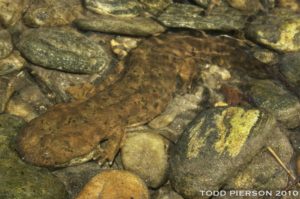
As we splash and swim through the water, beneath us, at home among the stones of the stream, Elimia christyi, an olive-colored freshwater mollusk with a conical shell – a species endemic to the river basin – burrows into the sediment. I like mollusks well enough, but, to my surprise, just as we are moving into our kayaks, a hellbender is swimming among the stones just a few feet away. The hellbender is a large aquatic salamander, a “dragon” of freshwater streams. The species requires cool, free-flowing waters largely free of pollutants and excess sediment. The magnificent creature has evaded me all my life – I hope to talk with one someday. The salamander is a fully aquatic species and has inhabited the streams of the eastern part of North America for the last sixty-five million years. Sadly, without more conservation efforts, they could be extinct.
We recovered from our second fall into the Hiwassee rather quickly. Eli maintained good spirits with his mom, but he very clearly did not want to tip over again. He gripped the sides of the kayak so hard his knuckles turned white. With the boy secure in Katie’s kayak, she and I share a look – we’ve made a mistake, and have a long day ahead of us. Knowing this, we decide to really live up the calm stretches of river.
Luckily, along Cane Island we can relax a good spell. From our vantage point, we see a crystal clear, calm current. Our waters glide us nicely along as we are hugged by beautiful mountain terrain. All around us, the recovering forest showers us with life. The waters gently twirl in a summer breeze. Reeds and grasses bend back and forth in rhythm, while the leaves of the forest trees appear so bright green, they seem like phantoms in the sun. We take our time, tell stories, and, most of all, stay calm.
Past Cane Island, the river widens along a beautiful stretch of form and color. No words from either science or poetry, reason or romance, can do justice to the natural world around us. The sound is still – nothing but the rippling, bubbling current.
Suddenly, the burble becomes a loud ovation as rapids quickly approach.
Katie is stern with a concentrated look on her face.
“Okay baby boy,” she cautions Eli, “we can do hard things.”
Come back Thursday for the second part of “Rhythm: Kayak Adventure,” and find out how Grant and his family battle the rapids!
**Featured image by Benjamin Davies on Unsplash, cropped
